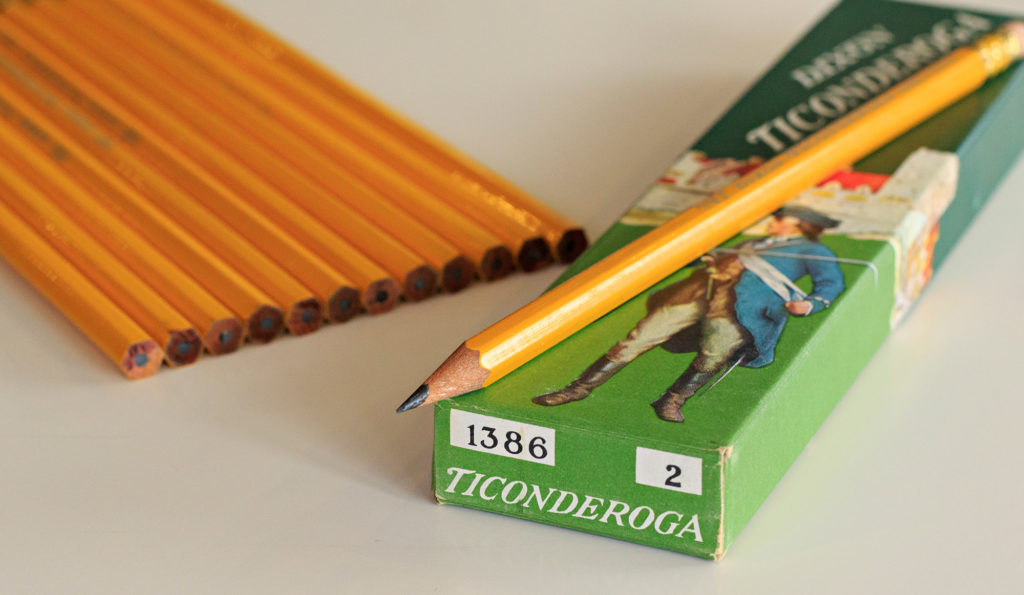America’s Pencil: The Dixon Ticonderoga
In honor of International Pencil Day 2022 I’ve put together a nice variety of five Dixon Ticonderoga pencils. The set comes with a free sticker that’s inspired by a very early Ticonderoga box (click below to see it). If you know anyone who is thinking about starting their own pencil collection, this is a great place to start.

So what’s the story behind this iconic American pencil? Let’s take a look.
A brief timeline
Way back in 1812 a young man by the name of Joseph Dixon created his very first pencil, and a few years later established a business producing pencils in Jersey City, New Jersey. It would eventually be called the Joseph Dixon Crucible Company and go on to become one of the most dominant players in the world of pencil manufacturing.
In 1873 Dixon acquired the American Graphite Company which was based in Ticonderoga, New York.

The familiar yellow No.2 Ticonderoga pencil was first introduced in 1913, however, its iconic green ferrule with yellow stripes did not become part of the brand image until 30 years later. Originally made of unpainted brass, the ferrule was temporarily changed to green plastic and cardboard in the early 1940s due to metal shortages caused by World War II. (Read more about WWII-era pencils here.) The distinct color scheme is still found on Ticonderoga pencils to this day.
In 2005, after more than two centuries as an independent American pencil producer, Dixon was purchased by FILA (Fabbrica Italiana Lapis ed Affini), an Italian company that makes pencils and other art supplies. While the Ticonderoga brand lives on, the pencils are sadly no longer manufactured in the U.S.A.
Small town, big history
Located in Essex County, a scenic area in upstate New York, is the small town of Ticonderoga. It has around 5,000 residents, and is a stone’s throw from Fort Ticonderoga. This modern-day museum of history documents the important role this military complex played in America’s defeat of the British nearly 250 years ago.

Around 40 years after the American Revolution, graphite ore was discovered on nearby (and appropriately named) Lead Hill in 1815. Graphite mining became a booming industry for the Ticonderoga community, and the area supplied lead for many American pencil manufacturers including Dixon.
Ticonderoga models through the decades
Dixon originally produced the Ticonderoga with five lead hardness levels, and assigned each a unique ID number beginning with 1385. Here’s how the numbering system was typically applied in those early days:
- No.1 = 1385
- No.2 = 1386
- No.2 5/10 = 1387
- No.3 = 1388
- No.4 = 1389
Later, however, Ticonderoga pencils marked 1385–1389 were all changed to 1386, and then sometime shortly after WWII were changed again to 1388. And … the 1385s became pencils with oversized erasers. Let’s just say they weren’t exactly consistent. But for pencil collectors like me, this just makes hunting down all the variations that much more fun and interesting.


By my count at least 11 different numbered models were produced over the span of about 100 years, but it’s hard to pinpoint exactly why certain numbers were assigned to certain models.
Most Ticonderoga pencils have hexagonal barrels. But at least a couple of the early models were round. Most had ferrules and erasers, while a few did not. If you ever come across a round Ticonderoga without a ferrule (such as the elusive 1360), it’s a rare and special pencil indeed.
Here are some examples of each of the model numbers I have in my collection.










The Dixon Ticonderoga is a well-loved pencil with a rich history. You can explore a total of more than 60 different Ticonderoga models in my online museum, some of which are available to purchase.